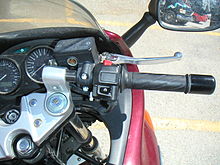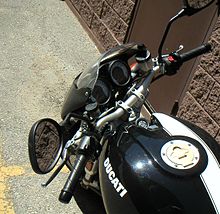- Motorcycle handlebar
-
Motorcycle handlebar refers to the steering mechanism for motorcycles. Handlebars often support part of the rider's weight, and provide a mounting place for controls such as brake, throttle, clutch, horn, light switch, and rear view mirrors.
Contents
Types of handlebar
Handlebars come in a variety of types designed for particular types of riding.
- Ape hanger handlebars rise far above the mounting location so that the rider must reach up to use them, hence the name. They are popular on chopper motorcycles. They are available in heights up to 20 inches. Some jurisdictions have regulations on how high the handgrips may be above the seat.
- Z-bar, any sharply angled handlebar with either long or short straight rise sections, which are sharply angled upward from the mounting points and again sharply angled to the handgrip and control area. Z-bars can be ape hangers, but not all ape hangers are Z-bars.
- Beach bars, similar to cruiser bars, slope back toward the rider to allow a relaxed riding position.
- Clip-ons are popular on sport bikes, in which two separate short handles are attached directly to the fork tubes, as opposed to a standard one-piece handlebar attached to the top of the triple tree.
- Clubman bars are common on cafe bikes. They clamp to the triple tree and are angled forward to give the rider a more aggressive riding position.
- Cruiser handlebars tend to be long and slope towards the rear of the motorcycle so that the rider can sit upright.
- Buckhorn handlebars are a variation on the ape hanger, but shorter, and always with a curved back section directly before the part of the bar that mounts the handgrips and controls. These are often thought to be one of the most comfortable type of handlebar, keeping the arms in a very natural and relaxed position in front of the rider. They are often called "mini-apes" (miniature ape hangers), but a true buckhorn must be rounded on top, never with the sharp angles of a Z-bar on the top.
- Drag bars are nearly straight across to create a forward-leaning and aerodynamic riding position.
- Motocross bars are tubular bars that are clamped onto the triple tree. They are common on motocross and off-road motorcycles, as well as dual-sport, streetfighter, and supermoto bikes.
Construction
Handlebars are made from hollow metal tubing, typically aluminium alloys or chrome plated steel but also of carbon fibre and titanium, shaped to the desired contour. Holes may be drilled for the internal routing of control cables such as brake, throttle, and clutch. Risers hold the handlebars above their mounting position on the upper triple tree or the top of the fork, and may be integrated into the bar itself or separate items.
Bar-end weights are often added to either end of the handlebar to damp vibration by moving the bars' resonant frequency away from that generated by the engine. Electrical heating elements may be added under the handlebar grips to provide comfort to the user in cold weather.
Sizes
There are several size parameters that describe most motorcycle handlebars.
- Width from grip to grip may vary from 30.5 inches to 37 inches.
- Rise above mounting location may vary from 0 inches to 20 inches.
- Pullback, the distance grips are behind their mounting location, may vary from 4.25 inches to 17 inches.
- Diameters vary, commonly 7/8 inch, 1 inch, and 1¼ inches, though oversized bars of 1¼, 1½ and 1¾ inches may reduce to 1 inch at the grips so standard controls may be mounted.
See also
References
Categories:- Motorcycle technology
Wikimedia Foundation. 2010.



